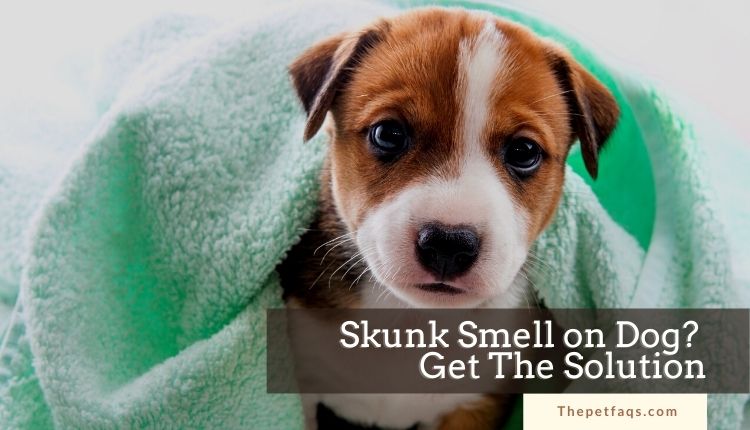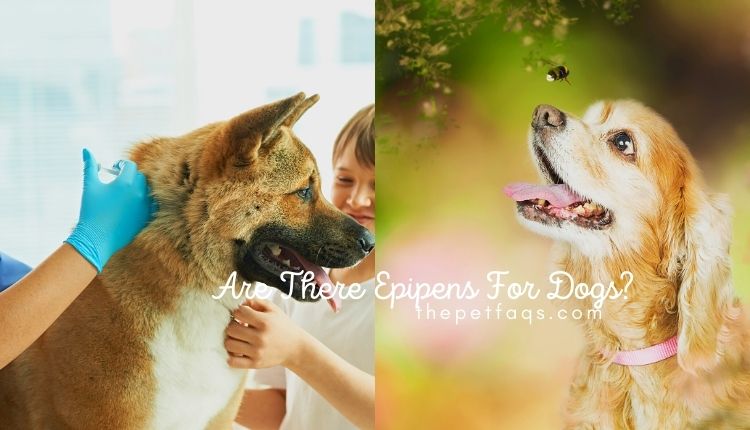How To Get Rid Of Lingering Skunk Smell On Dog?
There is no perfect solution to eliminate the skunk smell from a dog’s coat. However, if you follow these simple steps and are determined enough, you can remove the smell. We have outlined some of the best tips about how to get rid of lingering skunk smell on dogs.

How to Get Skunk Smell Off a Dog:
Use a fresh, clean, and cool towel to wipe off the area where you found skunk spray marks from your dog. The cloth should need not just one time but twice before being disposed of.

Wipe pores in between the dogs’ fur – by using a soft toothbrush (paintbrush), wet out two bowls with water and place it on the floor, then let your dog jump over them so that he can lick his hair off.
If he doesn’t lick the water, get another bowl and do it again since his hairs are up close to each other, and you should have a good chance of getting rid of skunk smell using this method.
Next, sprinkle baking soda on the fur – understand that if your clothes may be stench-exposing, then there is no better way than letting them spend some time in the home where they might pick up dirt from plants or carpets.

Baking soda acts as a deodorizing agent, which will eliminate the skunk smell from your dog’s coat. First, however, you need to spray it over the whole body after wetting the hair before sprinkling baking soda on them.
Then, rinse off with water – let some cold or hot water run through your dog’s fur in order to make sure all of the salt is removed and that no more odor would be formed than what’s been created in the first two days.
By knowing how to get skunk smell off dogs, you should be able to solve many small problems which may occur with your pets at home and when out on walks. However, if you have never cleaned up a dog’s fur before then, we suggest that it is best if you do so using this guide or any other proven technique for getting rid of skunk scent from a pet without having too much hard work. With fewer expenses, then you might not be as careful about cleaning up your dog’s fur.
What to Do First If Your Dog Is Sprayed by a Skunk:
Wash your dog gently with a gentle shampoo that is made especially for dogs
There are many to choose from at most pet stores (not just the ones mentioned in this article). If using the wrong one, you could worsen his damage and make it worse, which will cause him discomfort or even shock-like symptoms if he feels like he has gotten into something bad after all.

It is crucial not to put any conditioner or fragrant product on the dog if it has been sprayed to avoid further damage.
Instead, massage gently, ensuring that all shampoo is washed off and onto his fur as quickly as possible after drying him (or she), it could help prevent more areas from being affected than just those where shampoos were applied and prevent any bad odor build-up which might trigger an allergic or fungal reaction or make him feel sick. After this,
it is important to allow his hair to dry on its own, without any interference.
After the process of drying is complete, it could help if you brush through your dog’s fur so that all broken hairs are removed, and so he smells a bit better right away (morning breeze or fanning is always good). Shaving or clipping might be preferable but make sure no trimming was done anywhere around the area where shampoos were applied, right after a lot of flying fur becomes released in the air, which is making him feel itchy.
It is also recommended to apply an ointment (either spray or cream-based version easily available at your local pharmacy)
this will help provide some soothing relief by reducing itching and irritation present if his dry skin has irritated badly to scratching while being wet.
Wherever you live may determine how easy it could be to get the dog shampoo you need; after reviewing the list of places with AAVSO,, we realize that it really depends on where exactly in Canada and overseas people from northern areas tend to live.
Of course, having a pet at home can be owned by almost every Canadian since some provinces have previously transitioned towards high animal adoption rates (especially personal dogs), which should also surely agree why more pets are being kept as the year 2016 comes near its end already and accepted as a control method currently taken against fleas and ticks.
How to get rid of lingering skunk smell on dogs? Safe Methods to Get Rid of the Skunk Smell on Dogs
Method 1: Hydrogen peroxide, baking soda, and dish soap
Mix 1 teaspoon peroxide with a solution of baking soda (a much lesser concentrated version than we normally use) until you get the concentration that’s best for addressing skunk odors, to which add at least ¾ cup dish soap.

Then apply the mixture in a very thin layer, starting from his neck and base of tail up to just above where you feel some odor is coming. Be careful not to go over an area more than once, as he might scratch at it or even lather up (once you have applied the mixture to his fur in that location), but if irritation does occur, quickly remove and wash him with soap before reapplying treatment.
You can definitely leave your dog for an extended period of time however you wish because this method is very safe through a process using non-toxic ingredients. Even though always cleanse off whatever remains of its application and never repeat going in one very same exact hole on his equipment, if you have the time to do this may change where it causes him discomfort plus keep skunk odor at bay.
Method 2: Tomato juice

Fill a tub with water, add 5-10 drops of tomato juice, and 50mL hydrogen peroxide (if you do, use straight on its skin to kill ticks) for every 100 liters. Let it sit overnight or up to three days in an outdoor garden patch at least 40cm above the ground. Then rinse him off by pouring through this mixture when you bathe your dog if he has been treated with chemicals consisting mainly of volatile organic hydrocarbons that have a property of diffusion and are difficult to remove.
Tomato juice is also great for eliminating bad smells, including skunk odors!
Method 3: A feminine hygiene product
Suppose you have a dog that is overly possessive of his urinate, such as having the bathroom habits of an ill-mannered gentleman. In that case, applying this will be like throwing gasoline on your fire!

It’s never wise to introduce human toiletry with animal products. It should not even be used on small animals because it contains estrogen and other ingredients that are extremely toxic in their concentrated form for dogs or cats. But also remember that it’s a true miracle worker in the simplicity of its usage.
One way to dissipate odor is to use a feminine deodorant that at least contains one active ingredient, as mentioned earlier, containing hydrogen peroxide that kills but doesn’t have any smelly scent on yourself! You can follow application instructions if you will feel comfortable using products with colors and fragrances added in order not to take away from their pleasant odorless nature, but at least you will stop the smell and help eliminate it.
To remove the negative effects of bad odors on your dog or cat due to its urinal behavior, consume two tablespoons a day mixed with one teaspoon of baking soda in warm water.
Method 4: Skunk-specific shampoo, spray, or soaker
There are products that have skunk-specific scents incorporated into them. These contain a very strong odor killer, and for this reason, many consider them to be bad for cats but good for dogs because the canines’ sense of smell is capable of recognizing the odor long before their owners can.
The principle of creating and applying a skunk-specific solution is to saturate the dog’s coat with odor eliminators like several drops of essential oil in one-liter warm water that contains some essential oils, then apply it as you would normally shampoo your dog. Generally speaking, this method works well on dogs because they have much more sense of odor than cats do! It might provide temporary relief, but there are too many other factors involved in skunk odor elimination to consider it as a source that will completely get rid of the bad smell.
Additional Method: There’s one more scent-neutralizing method you can use
which is simply to remove your dog or cat from contact with skunks and their urines. People who have done this noticed within several days they no longer smelled strongly! It goes without saying how important the last option is, especially if the animal already has experienced so much whenever encountering the skunk smell at a close distance.
One’s dogs have to complete smells more strongly than cats. Therefore, this fact makes the former more susceptible to their ruins effects and endangers them from being poisoned in case they did not already develop immunity. This is why there are many people who say that having some sort of natural remedy for flora-based odors should be able to help animals become free from similar bad scents sooner or later. There’s a peculiar item you can use that comes from the same plant kingdom but is completely separated by your dog. It’s catnip.
This grass increases the disposition to climb on trees and bushes in potential members of your feline family, so when it does not get going them into ladders or other places they might normally enjoy having adventures skunks are unlikely to see any opportunities for their dear ones to come running back towards them when giving them purposeful exercise. Besides this, some pets also find it more soothing when skunks spray their pheromones elsewhere instead of on the pet itself, so you must keep in mind to give your cat plenty of natural remedies for flora-based odors, or they will react just like all other animals: running away from the scent whenever possible – and that could probably take a long time before these smells vanish completely!
Conclusion:
You shouldn’t dismiss the warning signs immediately when a skunk only comes off spraying your property. All it takes is 5 seconds after they feel that something’s been disturbed in their place before they start making loud sounds so they can lift any of those smells away from themselves and also decrease their chances to make additional relations with wild animals being where these creatures are around.
If you want more info on how to treat an animal if it comes into contact with skunk spray, don’t hesitate to check out all the resources provided below, starting with everything you need to know about this insect’s scent, its reaction, and also how it can help animals react when they’re in a painful state of affairs.





